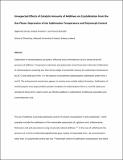Unexpected effects of catalytic amounts of additives on crystallization from the gas phase: Depression of the sublimation temperature and polymorph control

View/
Date
2016-04-11Author
Kamali, Naghmeh
Erxleben, Andrea
McArdle, Patrick
Metadata
Show full item recordUsage
This item's downloads: 394 (view details)
Cited 16 times in Scopus (view citations)
Recommended Citation
Kamali, Naghmeh, Erxleben, Andrea, & McArdle, Patrick. (2016). Unexpected Effects of Catalytic Amounts of Additives on Crystallization from the Gas Phase: Depression of the Sublimation Temperature and Polymorph Control. Crystal Growth & Design, 16(5), 2492-2495. doi: 10.1021/acs.cgd.6b00415
Published Version
Abstract
Sublimation of carbamazepine, piracetam, diflunisal, and p-minobenzoic acid is enhanced by the presence of additives. Temperature reductions and polymorph control have been observed. Sublimation of carbamazepine containing less than 5% by weight of acetamide reduces the sublimation temperature by 20 degrees C and yields pure form I. In the absence of acetamide, carbamazepine sublimation yields forms I and III. The enhancement mechanism appears to involve more volatile adduct formation. Sublimation of carbamazepine onto polycrystalline powder templates of carbamazepine forms I, II, and III yields pure samples of these forms. Valeric acid is an effective additive in sublimations of diflunisal, piracetam, and p-aminobenzoic acid.

